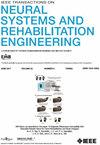Enhanced Brain Functional Interaction Following BCI-Guided Supernumerary Robotic Finger Training Based on Sixth-Finger Motor Imagery
IF 4.8
2区 医学
Q2 ENGINEERING, BIOMEDICAL
IEEE Transactions on Neural Systems and Rehabilitation Engineering
Pub Date : 2025-04-21
DOI:10.1109/TNSRE.2025.3562700
引用次数: 0
Abstract
Supernumerary robotic finger (SRF) has shown unique advantages in the field of motor augmentation and rehabilitation, while the development of brain computer interface (BCI) technology has provided the possibility for direct control of SRF. However, the neuroplasticity effects of BCI-actuated SRF (BCI-SRF) training based on the “six finger” motor imagery paradigm are still unclear. This study recruited 20 healthy right-handed participants and randomly assigned them to either a BCI-SRF training group or a sham SRF training group. During the testing phase before and after 4 weeks of training, all participants were tested for SRF-finger opposition sequence behavior, resting state fMRI (rs-fMRI), and task-based fMRI (tb-fMRI). The results showed that compared with the Sham group, the BCI-SRF group improved the accuracy rate of the SRF-finger opposition sequence by 132%. The activation analysis of tb-fMRI before and after training revealed a significant increase in left middle frontal gyrus only in the BCI-SRF group. In addition, the BCI-SRF group showed an increase in FC between the right primary motor cortex and left cerebellum inferior lobe, as well as between the left middle frontal gyrus and the right precuneus lobe after training, while there was no significant change in the Sham group. In addition, only the BCI-SRF group showed a significant increase in clustering coefficients after training. Moreover, the increase in the clustering coefficients of the two groups is positively correlated with the improvement of the accuracy of the SRF-finger opposition sequences. These results indicate that the integration of BCI and SRF significantly regulates the functional interaction between motor learning and cognitive imagery brain regions, enhances the integration and processing ability of brain networks for local information, and improves human-machine interaction behavioral performance.基于六指运动意象的bci引导下机器人多余手指训练后脑功能交互增强
多余机械指在运动增强和康复领域显示出独特的优势,而脑机接口技术的发展为直接控制多余机械指提供了可能。然而,基于“六指”运动意象范式的脑机接口驱动SRF (BCI-SRF)训练的神经可塑性效应尚不清楚。本研究招募了20名健康的右撇子参与者,并将他们随机分配到BCI-SRF训练组和假SRF训练组。在训练前后4周的测试阶段,所有参与者都接受了srf -手指对立序列行为、静息状态功能磁共振成像(rs-fMRI)和基于任务的功能磁共振成像(tb-fMRI)测试。结果表明,与Sham组相比,BCI-SRF组将srf -手指对立序列的正确率提高了132%。训练前后的tfmri激活分析显示,只有BCI-SRF组左侧额叶中回显著增加。此外,BCI-SRF组训练后右侧初级运动皮层与左侧小脑下叶之间、左侧额叶中回与右侧楔前叶之间的FC增加,而Sham组无明显变化。此外,只有BCI-SRF组训练后的聚类系数显著增加。此外,两组聚类系数的增加与srf -手指对立序列准确率的提高呈正相关。这些结果表明,脑机接口与SRF的整合显著调节了运动学习和认知意象脑区之间的功能交互,增强了脑网络对局部信息的整合和处理能力,改善了人机交互行为表现。
本文章由计算机程序翻译,如有差异,请以英文原文为准。
求助全文
约1分钟内获得全文
求助全文
来源期刊
CiteScore
8.60
自引率
8.20%
发文量
479
审稿时长
6-12 weeks
期刊介绍:
Rehabilitative and neural aspects of biomedical engineering, including functional electrical stimulation, acoustic dynamics, human performance measurement and analysis, nerve stimulation, electromyography, motor control and stimulation; and hardware and software applications for rehabilitation engineering and assistive devices.

 求助内容:
求助内容: 应助结果提醒方式:
应助结果提醒方式:


